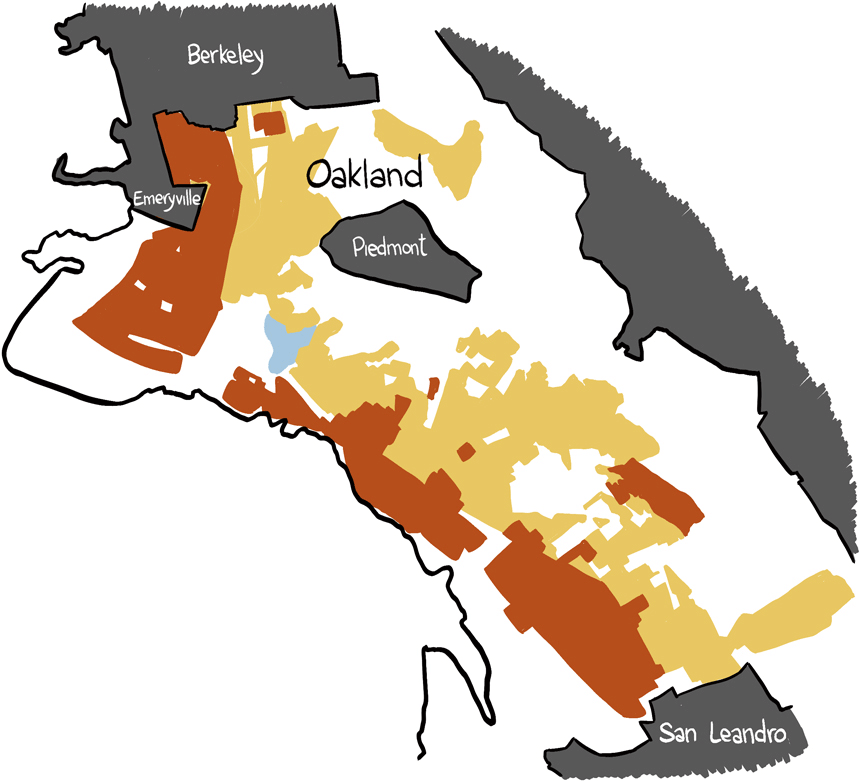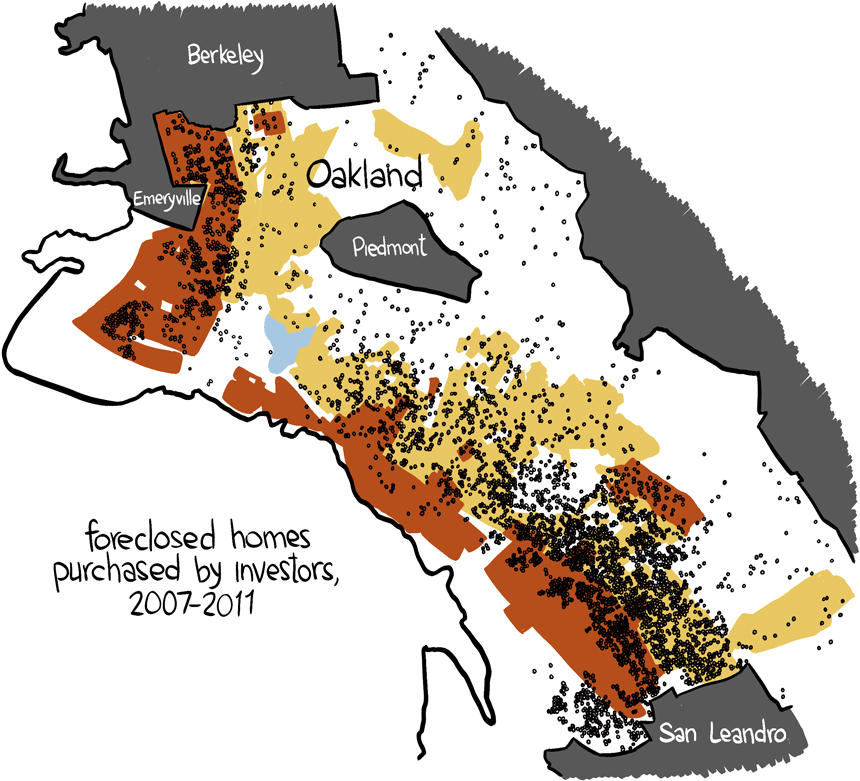Are You A Vanguard? Applications Now Open
This is your first of three free stories this month. Become a free or sustaining member to read unlimited articles, webinars and ebooks.
Become A MemberGentrification: We think we know it when we see it. Pour-over organic coffee, double-wide designer strollers, gluten-free options. Millennials and their unrelenting desire to live and work in cities that pushes out longtime residents. A tide rising, cresting and washing over. An act of nature.
These demographic and economic shifts in cities aren’t the result of organic social and cultural trends; the changes are wrought by decades of investment and public policy choices, and inextricably bound to histories of racism, exclusionary land use policies and exploitative banking processes that left certain communities vulnerable to a steamroller of new investment.
“If you don’t know what the problem is you definitely can’t stop being a part of it, and I think a lot of people don’t know what the problem is,” says DeeDee Serendipity, a native of Oakland who now owns a salon in the city.
Massive waves of disinvestment and reinvestment have brought a sea change to Oakland, and it’s only just begun. The city is at a crossroads it can’t ignore: Current economic growth could create opportunity or be squandered. The city can determine its future — choose progressive policies to stem displacement and aid existing low- and middle-income residents, or side with business interests, inviting higher-end investments and opportunities. Or it can do nothing, and let the market sort it out.
Oakland has long been at the center of a national conversation about equity, but it’s quickly becoming a more enticing beacon for venture capitalism than for social justice.
On the same sun-dappled courthouse steps where decades ago Black Panthers stood in uniform, armed and organized for the power and self-determination of people of color, an auctioneer sets up with a folding chair and a stack of documents. Would-be investors gather around. This is where Oakland’s foreclosed homes are sold to the highest bidders.
Between 2006 and 2011, 10,508 homes — more than 7 percent of the city’s households — were foreclosed and repossessed. These bank-owned homes were concentrated in West and East Oakland, and most were occupied by people of color — and had been for generations.
In the first half of the 20th century, Oakland’s population exploded with new residents eager to work in the city’s car factories and shipyards. The western neighborhoods near the train line terminus became a popular settlement for immigrants. Bank documents from the 1930s redline nearly all of West Oakland, listing it as an undesirable area in which to lend because of an “influx of Negroes and Orientals.”

Sometimes activists try to disrupt these auctions, delaying the process for what they hope will be enough time to renegotiate with lenders. They bring bullhorns, noisemakers, wind instruments. It usually doesn’t work.
Over the last decade, thousands of Oakland residents have lost their homes to investors planning to primp, paint and flip them into more luxurious rentals. Some of those homes purchased for $135,000 now rent for $3,000 a month. For renters pushed out of San Francisco, this is a bargain, while many families who used to live in these homes have sought cheaper housing in far-flung suburbs.
In 2012, the Urban Strategies Council research nonprofit found that large investors ultimately scooped up 45 percent of bank-owned properties, and only 10 of the top 30 companies were based in Oakland.
“It essentially stripped Oakland of its homeowners, it stripped local wealth,” says Anya Svanoe of the Alliance of Californians for Community Empowerment.
The report was one of the first close looks at how the foreclosure crisis would play out over the long-term, recalls author Steve King. “We could see that something much bigger was going on here.”

One investor, Neill Sullivan of Oakland-based REO Homes, bought upwards of 270 bank-owned parcels, mostly in the poorer neighborhoods of West Oakland. “REO Homes LLC has been able to infiltrate a community beset by a crisis and cobble together a sizable fiefdom,” King wrote.
A spokesperson for Sullivan was quoted in 2012 telling a reporter that the company wanted “to bring in good, productive people and really change the area.”
This property rush is likely just beginning for the post-industrial city once known as the Detroit of the West. “Oakland’s finally getting some good press in terms of it being a viable place to invest in, but it’s always been a great place for investment,” says Simon Chen, chief financial officer for Oakland-based development firm Madison Park Financial. “Oakland is where the opportunity is.”
Madison Park president John Protopappas grew up in Oakland, and in the 2000s, he became tight with then-mayor Jerry Brown (now California’s governor). The developer helped shape Brown’s urbanist “10K Plan” to attract 10,000 new residents to the city’s downtown, a plan for investment and housing construction that laid groundwork for the city’s current boom. Today, Brown is an investor in Madison Park.
For developers, the market is working very well: A large one-bedroom in Madison’s Lampwork Lofts development in West Oakland recently rented for $2,050, even before realtors could show it at an open house. Meanwhile, it’s left everyone else on the brink. Urban Strategies’ recently completed Housing Equity Roadmap found that the entire city is facing an affordability crisis.
“Essentially in every neighborhood in Oakland, the median income earner cannot afford the median rental price. And then there’s a sort of filtering down of neighborhoods,” says King. “That certainly has a disproportionate impact on the lowest income people — they’re the ones being displaced.”
That displacement has had other disproportionate demographic effects: Between 2000 and 2010, Oakland’s black population fell by 25 percent, along with its population of school-age children.
For nearly 100 years, in its many iterations, Oakland has been synonymous with cool — from jazz and blues to hip-hop and graffiti. As Oakland’s population changes, so too does the culture that drew so many new residents in the first place.
Sculptor Karen Cusolito first arrived in West Oakland in 2005, when her search for a studio to build large-scale art pieces for Burning Man landed her in the former American Steel factory.
In 2009, she signed a lease on the entire six-acre building. It’s now divided into more than 170 studios and workshops for a variety of artists. “I look at our demographics in terms of creativity. If you’re looking in terms of ethnicity, it’s still pretty white,” she says.
To many, American Steel and “the Burners” have come to represent privileged outsiders who move to the city without sensitivity to local needs. One art teacher told me that they suck up all the grant money, leaving less for other local programs and projects. When some American Steel Studios artists took their “art cars” out to a party in West Oakland earlier this fall, they were decidedly unwelcome. Partygoers pelted them with bottles, and tagged the back of one of the cars.
The various tensions played out politically in November when Oakland voters elected a solidly middle-ground, consensus-oriented new mayor, Libby Schaaf. An aide to former Mayor Jerry Brown and a member of the City Council with political savvy and a reputation as a policy wonk, Schaaf campaigned on a vision for a city with room enough for everyone — longtime residents, newcomers and those yet to arrive. Madison Park president John Protopappas served as her finance chairman and she won endorsements from local labor unions.
Thousands of units of new market-rate and affordable housing are now in construction or planning phases and the Mayor-elect, who will be sworn in early next month, is clear about her intentions for increasing the supply even more dramatically. Schaaf says she is exploring developer impact fees as well as tax abatement programs designed to convert existing rental stock into subsidized affordable housing. “So much of a family’s support structure is geographically based,” she says.
“To the extent that we can protect people where they are, I think we can do that more quickly than we can build new buildings, and you preserve that ecosystem of support.”
But for many Oakland families, that ecosystem is already crumbling. “It’s very difficult to put any limitations on the private market,” says King, who worked with Urban Strategies and others to create a community land trust.
A rising tide may lift all boats, but many in Oakland can only afford lifejackets.
One promise of gentrification is a larger tax base and new jobs — rising housing costs would not have such a disruptive impact on life for Oakland residents if its industry could just keep pace. Today, Oakland’s unemployment hovers at 9 percent, which is down significantly since a 2010 high, but still more than anyone would like.
Many, including Schaaf, are pinning hopes on the tech industry to help change that. Oakland is geographically well-positioned to absorb San Francisco and Silicon Valley’s trickle-down. Last year, the city attracted $242 million in venture capital, a sum that placed it 13th in a National Venture Capital Association ranking of U.S. cities.
An old Sears department store was recently purchased for renovation into offices for tech companies; sources close to the project say that Google is looking to expand there, joining Ask.com and Pandora, which already operate in the city.
“When I tell people I work in a tech company in Oakland, a lot of people respond like, oh, that’s really happening now, isn’t it?” says Brennen Byrne, CEO of digital security startup Clef. “If we can make Oakland succeed while Clef succeeds, we’ll be much happier and we’ll build a better relationship with Oakland. Our job as a company isn’t to find the city that’s going to bet biggest on us, but to find a place where we can build something healthy and long-lasting.”
Clef operates out of the Port, a tech-centric co-working space on Oakland’s waterfront, not far from some of Jerry Brown’s “10K” condos. Outgoing Mayor Jean Quan recently cut the ribbon at the office’s grand opening for its 30-foot tube slide.
“There’s a lot of talk in Oakland about our tech sector looking different than Silicon Valley’s or San Francisco’s,” says Schaaf. “I want tech companies to choose Oakland because they share those values.”
Byrne says Clef supports Hack the Hood, an organization aimed at teaching low-income youth of color tech skills by way of building websites for small businesses. “We think that’s a really important cause, making tech accessible to Oakland so that as it grows here we can do as much as we can to hire locally and bring the community here up with us.”
It’s a tall order. According to net freedom advocates, more than half of the homes in West and East Oakland don’t have Internet access. Even when Oakland grows its own tech talent at home, there’s no telling if large tech companies — not exactly known for their diverse workforces — will actually hire them.
For all the glamour of the tech industry, Oakland’s fastest-growing job sectors are food service, hospitality and, yes, real estate. The city’s economic boom so far looks mostly like new bars and restaurants that are not catering to the minimum-wage set.
But despite all this homegrown service industry, many of Oakland’s gentrifying neighborhoods still lack basic amenities such as grocery stores and banks, let alone a wider variety of retail.
Often Oakland residents don’t even have the choice of shopping local. The closest grocery store to West Oakland is in Emeryville, the municipality next door.
“Oakland doesn’t have the tax money it needs. Retail is broken here,” says Angela Tsay, CEO of civic pride apparel brand Oaklandish, which opened its downtown storefront in 2012.
“We’re super-psyched that we’re going to start selling Levi’s,” she says. “We’ll be the only place in Oakland that you can buy regular 501s. Otherwise you have to go to some other city and give them your tax dollars.”
Anyka Barber is an Oakland native who left the city for 10 years before returning and eventually opening an art gallery, Betti Ono, a few storefronts down from Oaklandish. Shortly after returning to her hometown, she found herself feeling out of place at a local First Friday art walk. “It felt very homogenous and it did not speak to me,” she recalls. Since then, she has made it part of her mission to make sure that her community remains visible and vital as other populations claim space in the city.
Oakland is one of the nation’s most racially diverse cities: Its current population splits roughly in equal parts among Asian, Latino, African-American and Caucasian residents. “But it’s very segregated, it’s not diverse at each table,” says Serendipity.
The stretch of downtown where Barber and Tsay set up shop is one exception. When Oaklandish opened its retail store in 2012, says Tsay, it began selling to a broader variety of customers. “There is no one typical customer. There’s no population segment of Oakland that doesn’t find themselves at some point at 14th and Broadway.” They hope the new investment in Oakland will create other similarly diverse spaces.
For DeeDee Serendipity and her salon, the new Oakland isn’t all bad either.
“Hair salons are the last segregated business. It’s the place where people take their racism and are honest about it,” says Serendipity. “I built my business around being the only multicultural hair salon in Oakland, but nobody would come to me unless they knew what race I was, until gentrification happened and suddenly it was OK for me to be who I was. All of a sudden I have clients who are willing to come to me.”
The city has taken some steps to support homegrown entrepreneurs like Serendipity. In the spring of 2013, Oakland was the first American city to partner with Kiva, a nonprofit that disburses interest-free microloans to small businesses.
The tide of new development in Oakland hasn’t yet washed away the city’s deeply rooted culture, or its radical politics. Activists have won significant victories in recent years, including the defeat of a citywide surveillance fusion center bankrolled in part by the Department of Homeland Security. In November and December, several days of protests against police brutality brought the city to a standstill with highway shutdowns and significant property destruction in business districts.
The economic squeeze has helped prompt other progressive policies. Oakland recently passed a tenant protection ordinance aimed at ending landlord harassment. The superintendent of schools has proposed a 10 percent pay raise for teachers. And in November, voters passed a minimum wage increase in an 80 percent landslide, raising pay from the state minimum $9 per hour to $12.25 starting in March 2015 with the support of the new mayor. But those new wages will still be barely enough to meet basic living wage standards for a single adult, presuming they live with roommates, and rents continue to climb.
One thing on which almost all of Oakland can agree: There is no stopping the change.
“You can’t avoid the wave of gentrification in Oakland, and I don’t think it’s necessarily a bad thing,” says Madison Park Financial’s Simon Chen. “I mean, I’m a developer, I think it’s good for a city if for no other reason than it brings in more money for public services. The more money a city has, as long as it’s not completely incompetent, all the residents of Oakland would benefit.”
Mayor-elect Schaaf has said her number one priority for the city is public safety and hiring additional police officers for a department that many argue is understaffed. A heavier police presence in Oakland might quell property crime and put some new residents at ease, but it won’t be entirely welcomed in a city with a long history of police corruption and civil rights abuses.
“What I see is more death for my brothers,” DeeDee Serendipity tells me.
Cities are always responding to forces far greater than their geography: multinational financial firms, speculative industries and the institutional racism that has shaped American communities since their beginning. Oakland is no different.
Yet in its current growth mode, the city has the power to make choices and define its future.
Oakland, too, had a choice when the banks came for those foreclosed homes. It chose not to act while thousands of the city’s most vulnerable residents were pushed out of their homes.
And this crisis, too, may in turn lead to the next one. “If anything we’re seeing that it’s going to happen again,” says Anya Svanoe of Alliance of Californians for Community Empowerment. “With all these speculators buying up properties and flipping them for a profit, that’s the same sort of trend that we saw 10 years ago.”
For the city to truly thrive, it must escape this cycle of crisis, of boom and bust, of urban disinvestment and unregulated reinvestment. In this, perhaps, Oakland has no choice at all.
Our features are made possible with generous support from The Ford Foundation.

Susie Cagle is a reporter and illustrator based in Oakland, California. Her work has appeared in The Nation, Al Jazeera America, Medium, and elsewhere.

20th Anniversary Solutions of the Year magazine